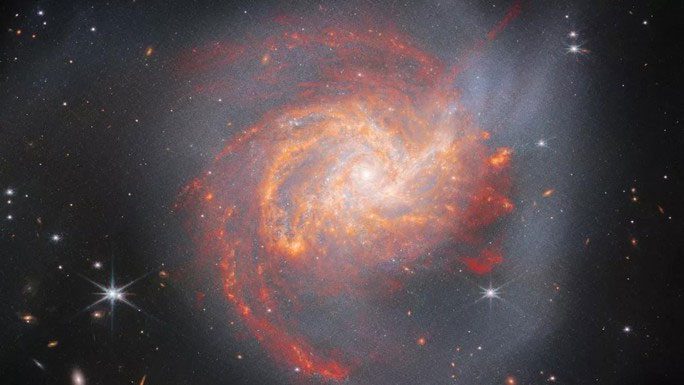A massive orange-red object has appeared in data collected by the James Webb Space Telescope, which may represent the image of our “monster” galaxy 5 billion years in the future.
The James Webb Space Telescope, developed and operated by NASA, has just recorded a strange galaxy known as NGC 3256. It is enormous, with an orange-red hue, extremely turbulent spirals adorned with long strands filled with dust and stars, shining like a vibrant octopus.
According to Space, scientists refer to it as “the wreckage from the collision of cosmic Titans.” Titans are the primordial giant gods in Greek mythology. The two ancient galaxies that merged to form NGC 3256 were Titans as well.

NGC 3256 may be the future of the “monster” pair Milky Way – Andromeda – (Image: NASA).
In other words, NGC 3256 is unique because it is the remnants of a relatively recent galaxy merger captured by James Webb, when the newly formed galaxy from that event was still chaotic.
The orange-red color of the galaxy in the recently discovered image by NASA is indicative of vigorous young star formation, emitting infrared light. James Webb is an excellent tool for capturing infrared radiation from deep space.
This galaxy is extremely large as it results from the collision of two galaxies classified as “monsters” in the universe, similar in size to the Milky Way galaxy that contains Earth.
“Studying these cosmic collisions can provide astronomers with a wealth of information about how galaxies like our Milky Way evolve by merging with other galaxies” – NASA scientists noted.
Since galaxy growth in this manner also leads to the merging and growth of black holes, research on this orange-red galaxy will also help solve the mystery of the largest supermassive black holes, which can be millions to billions of times the mass of the Sun.
For us, this can serve as a “time window” looking into both the past and future: The Milky Way is believed to have reached this enormous size through approximately 20 galaxy mergers.
In the future, two mergers are predicted to involve confrontations with the satellite galaxy Large Magellanic Cloud and the giant Andromeda galaxy, expected to occur in about 2 billion and 4-5 billion years.
Among these, the Milky Way – Andromeda collision is predicted to resemble the recently observed event, as both are “Titans” in the galactic realm.
Galaxy collisions typically do not destroy the celestial bodies within them; rather, they often stimulate the formation of new stars. However, there is a high probability that it could alter the position of the Solar System and the planets within it.
A grim scenario is predicted where Earth could be ejected from the “habitable zone” and face extinction, assuming life still exists here in 5 billion years.


















































